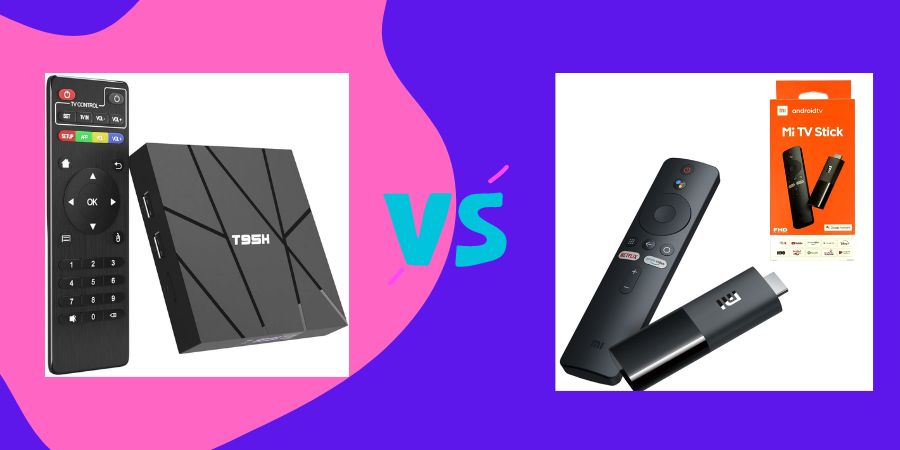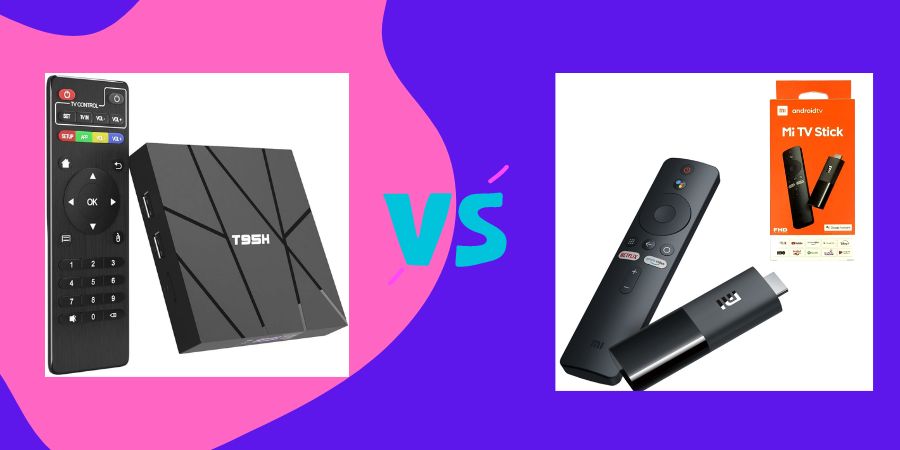Today, we’re diving into the exciting world of Android streaming devices. In this blog post, we’ll be highlighting five major differences between Android boxes and Android sticks.
So, let’s get to it and explore which option suits your streaming needs the best!
Android box vs Android stick- Comparison table
| Feature | Android Box | Android Stick |
|---|---|---|
| Size | Larger form factor | Compact and portable |
| Performance | Powerful hardware and better performance | Suitable for basic streaming and tasks |
| Connectivity | Multiple USB ports, HDMI, Ethernet, etc. | Limited ports due to compact design |
| Storage | Ample storage space and expandable options | Limited internal storage capacity |
| Customization | Supports advanced customization options | Limited customization due to compact design |
| Heat Management | May require additional cooling measures | Generates less heat due to lower power usage |
| Remote Control | Dedicated remote control for convenient use | Can be controlled via smartphone apps or remotes |
| HDMI Port Compatibility | Compatible with most HDMI ports | Versatile, fits into any HDMI port |
| User Interface | Enhanced interface and navigation experience | Simplified layout due to limited screen space |
| Price | Higher price range | More affordable options |
10 Differences between Android box and Android stick

1. Size Matters: Compact Stick or Mighty Box?
When it comes to size, Android sticks win the portability game, hands down! These tiny powerhouses easily fit into your pocket, making them perfect for travel or moving between TVs.
On the other hand, Android boxes are larger and typically require a dedicated space near your TV. Their bigger form factor allows for enhanced hardware capabilities and additional connectivity options.
2. Performance Prowess: Box Takes the Lead!
If you crave powerful performance, an Android box is the way to go. With beefier processors, more RAM, and advanced graphics capabilities, boxes deliver superior performance compared to sticks.
Whether you’re into heavy gaming or seamless 4K streaming, an Android box will keep up with your demands.
3. Connectivity Options: Boxes Offer More Flexibility
When it comes to connectivity, Android boxes take the cake. With multiple USB ports, HDMI outputs, and Ethernet connections, they offer a wider range of options to connect various devices simultaneously.
Android sticks, while still providing essential connectivity, often have limited ports due to their smaller size.
4. Storage Space: Boxes Give You More Room!
Need ample space for your apps, games, and media files? Android boxes are the winners in the storage department. Equipped with larger built-in storage or expandable options like SD card slots, boxes provide plenty of room for all your digital content.
Android sticks, while capable of storing essential apps, may have limited internal storage capacity.
5. Price Points: Sticks Offer Cost-Effective Solutions
If you’re on a tight budget, Android sticks are a wallet-friendly choice. They generally come at lower price points compared to Android boxes.
Sticks offer a great entry point into the world of streaming, making them an attractive option for those seeking an affordable yet capable streaming device.
6. Customization Options: Boxes for Tech Tinkerers!
If you love to customize and tinker with your streaming device, Android boxes offer a world of possibilities. With their larger size and more extensive hardware, boxes often support advanced customization options like flashing custom ROMs or adding external peripherals.
Android sticks, while still allowing for some customization, may have limitations due to their compact design.
7. Heat Management: Sticks Stay Cool, Boxes Get Heated!
When it comes to heat management, Android sticks have the upper hand. Due to their smaller size and lower power consumption, sticks tend to generate less heat during operation, resulting in a cooler streaming experience.
On the other hand, Android boxes, with their more powerful hardware, can generate more heat and may require additional cooling measures like built-in fans or heat sinks.
8. Remote Control: Box Brings Convenience!
Android boxes often come with dedicated remote controls that offer convenience and ease of use. These remotes typically feature navigation buttons, multimedia controls, and dedicated shortcuts, making it a breeze to navigate through your favorite apps and content.
While Android sticks can be controlled via smartphone apps or external Bluetooth remotes, the integrated remote control experience is a standout feature of boxes.
9. Versatility: Sticks Fit Any HDMI Port!
One of the advantages of Android sticks is their versatility in terms of HDMI port compatibility. These small devices can plug into any HDMI port, be it on your TV, monitor, or projector, offering flexibility in connecting to various display devices.
Android boxes, while still compatible with most HDMI ports, may require additional cables or adapters for certain setups.
10. User Interface and User Experience: Boxes Enhance Your Interface!
With their larger form factor, Android boxes often provide a more visually appealing and user-friendly interface on your TV screen. These boxes may offer customized launcher interfaces, grid-based layouts, and intuitive navigation menus, enhancing the overall user experience.
While Android sticks can still deliver a pleasant user interface, the limited screen real estate can sometimes result in a more condensed and simplified layout.
Frequently Asked Questions: Android Box vs. Android Stick
Can I install the same apps on both Android boxes and Android sticks?
Yes, both Android boxes and Android sticks run on the Android operating system, so you can install the same apps on both devices. However, keep in mind that certain resource-intensive apps or games may perform better on an Android box due to its higher hardware specifications.
Do Android sticks require a separate power source?
Yes, most Android sticks require a separate power source, typically through a USB port on your TV or an external power adapter. This is because the power supplied through the HDMI port alone may not be sufficient to run the stick.
Can I use a keyboard and mouse with Android boxes and Android sticks?
Yes, both Android boxes and Android sticks support USB or Bluetooth connectivity, allowing you to connect a keyboard and mouse. This can be particularly useful for tasks that require text input or navigating through certain apps more efficiently.
Can I use an Android box or Android stick with any TV?
Generally, yes! Both devices connect to your TV through an HDMI port, so as long as your TV has an HDMI port, you should be able to use an Android box or stick with it. However, ensure that your TV meets the minimum requirements for resolution (e.g., 1080p or 4K) to fully enjoy high-definition content.
Are Android boxes and Android sticks legal to use for streaming?
Yes, Android boxes and Android sticks themselves are legal devices. However, it’s important to use them responsibly and comply with copyright laws. Streaming copyrighted content without proper authorization is illegal. Stick to legal streaming services or use apps that offer licensed content to stay on the right side of the law.

